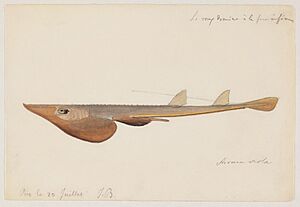Brazilian guitarfish facts for kids
Quick facts for kids Brazilian guitarfish |
|
|---|---|
 |
|
| Conservation status | |
| Scientific classification | |
| Genus: |
Pseudobatos
|
| Species: |
horkelii
|
| Synonyms | |
|
|
The Brazilian guitarfish (Pseudobatos horkelii) is a special type of fish that looks a bit like a shark and a ray combined. It belongs to the Rhinobatidae family. You can only find this fish living in the coastal waters of Brazil.
These fish are viviparous, which means they give birth to live young, just like mammals do. Their babies, called pups, are born in February after a long time growing inside the mother. Sadly, during this time, many of these fish are caught by fishermen. Because of too much overfishing, there are fewer and fewer Brazilian guitarfish left. The International Union for Conservation of Nature says this fish is "critically endangered", meaning it's at a very high risk of disappearing forever.
Contents
Meet the Brazilian Guitarfish
The Brazilian guitarfish was first described in 1841 by scientists Müller and Henle. They named it Rhinobatos horkelii to honor Dr. Johann Horkel, a German botanist. He had sent them a fish specimen to study.
What Does It Look Like?

This fish can grow up to about 138 centimeters (54 inches) long. But usually, adult fish are around 60 centimeters (24 inches) long. Their back is a plain olive-grey or brown color. They have a dark spot on their snout, and their nostrils are quite long. The top of their head is mostly flat.
How Do They Live?
The Brazilian guitarfish doesn't have many babies at once. They are viviparous, meaning the young grow inside the mother. Mating happens in March in the shallower parts of the ocean near the coast. After mating, the adult fish move to deeper waters.
The eggs stay inside the female in a special casing. They don't start developing until November, when the mother returns to the warm, shallow coastal waters. The young fish grow inside the mother, first getting food from a yolk sac, then from special fluids the mother provides. They grow from about 1 centimeter (0.4 inches) in December to about 29 centimeters (11 inches) when they are born in February.
Female guitarfish become adults at about 4 years old. They can have between 4 and 12 pups at a time, with larger mothers having more babies. The shallow coastal areas are very important "nursery" spots for the young fish. Here, both young fish and pregnant females are easily caught by certain types of fishing nets. Later in the year, the adult fish spread out more and can be caught by other fishing methods.
Why Are They in Danger?
The biggest problem for the Brazilian guitarfish is overfishing. This fish is often caught by different types of nets, like trawling nets and gillnets. For a long time, it was one of the most common ray-like fish caught along the southern coast of Brazil.
For example, in 1975, fishermen brought in 842 tonnes of these fish to the port of Rio Grande. By 1984, that number jumped to 1804 tonnes. But since then, the catch has dropped a lot. In 2002, only 157 tonnes were caught, and the numbers keep going down. In southern Brazil, the number of these fish has fallen by more than 80% since 1986.
Because of this big drop, the International Union for Conservation of Nature is worried that the Brazilian guitarfish could become extinct in about ten years if overfishing continues. That's why its conservation status is listed as "critically endangered". This means we need to protect them now!



